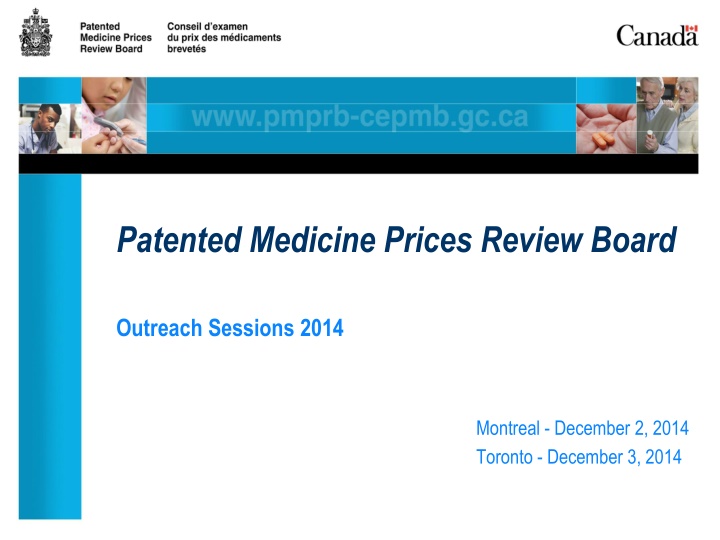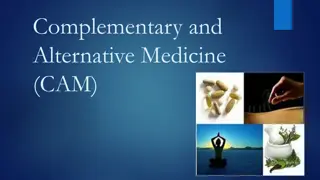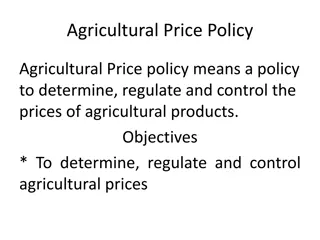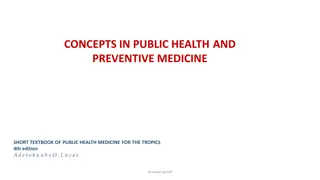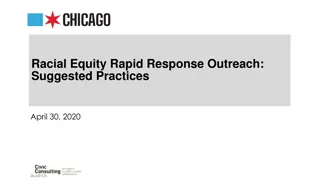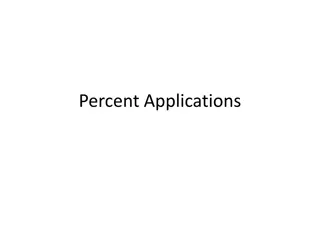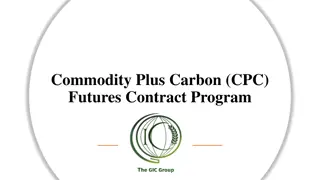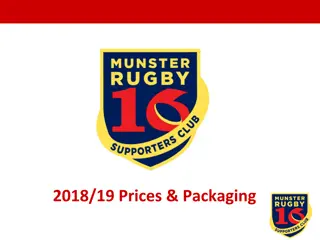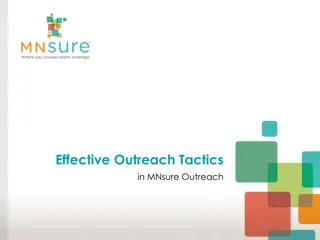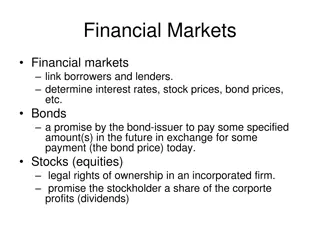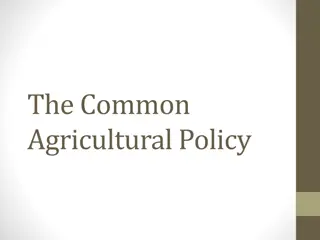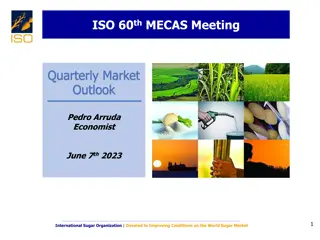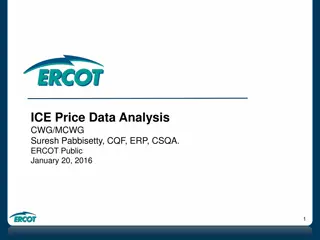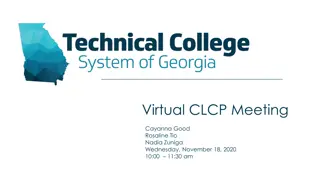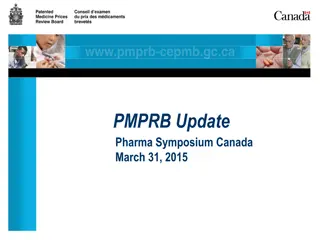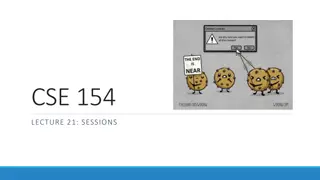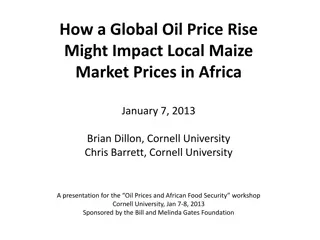Patented Medicine Prices Review Board Outreach Sessions 2014 Overview
The Patented Medicine Prices Review Board conducted outreach sessions in Montreal and Toronto in December 2014. The sessions covered best practices for Form 3 filings, regulatory updates, and requirements for patentees selling patented drugs in Canada. Form 3 submissions are mandatory to provide information on licensees, revenue sources, and research expenditures. Visit the provided links for detailed guidelines.
Download Presentation

Please find below an Image/Link to download the presentation.
The content on the website is provided AS IS for your information and personal use only. It may not be sold, licensed, or shared on other websites without obtaining consent from the author.If you encounter any issues during the download, it is possible that the publisher has removed the file from their server.
You are allowed to download the files provided on this website for personal or commercial use, subject to the condition that they are used lawfully. All files are the property of their respective owners.
The content on the website is provided AS IS for your information and personal use only. It may not be sold, licensed, or shared on other websites without obtaining consent from the author.
E N D
Presentation Transcript
Patented Medicine Prices Review Board Outreach Sessions 2014 Montreal - December 2, 2014 Toronto - December 3, 2014
PMPRB Participants Tanya Potashnik, Director, Policy and Economic Analysis Branch Jeff Biggs, Manager, Policy Development Joel Weber, Senior Regulatory Officer John Cook, Senior Regulatory Officer (Montreal) Kirk Stanley, Senior Regulatory Officer (Toronto) 2
Overview Best practices related to the filing of Form 3s Block 5 and Board Staff sources for Verification of International Prices Online filing tool update Update on the regulatory amendment regarding filing Interpretation Policy
Patented Medicine Prices Review Board Form 3 Jeff Biggs, Manager, Policy Development
Objectives To provide information on how to submit Form 3. More about Form 3 filing requirements and deadlines can be found in the Patentee s Guide to Reporting (http://www.pmprb- cepmb.gc.ca/view.asp?ccid=523#816). 5
Do I have to fill out a Form 3? If you are a patentee selling patented drugs in Canada, then you must fill out Form 3. If you are no longer a patentee but were a patentee during part or all of the year that Form 3 covers, you are still required to submit Form 3 information in respect of that calendar year. 6
Why should I fill out Form 3? Patent Act 88(1): A patentee of an invention pertaining to a medicine shall, as required by and in accordance with the regulations, or as the Board may, by order, require, provide the Board with such information and documents as the regulations or the order may specify respecting: (a) The identity of the licensees in Canada of the patentee; (b) The revenue of the patentee, and details of the source of the revenue, whether direct or indirect, from sales of medicine in Canada; and (c) The expenditures made by the patentee in Canada on research and development relating to medicine. 7
What counts as R&D? Patented Medicines Regulations, Section 6: For the purposes of subsection 88(1) of the Act, the expression research and development means those activities for which expenditures qualify, or would qualify if the expenditures were made by a taxpayer in Canada, for an investment tax credit in respect of scientific research and experimental development [SR&ED] under the Income Tax Actas that Act read on December 1, 1987. 8
Where do I find Form 3? Patentee s Guide to Reporting: http://www.pmprb-cepmb.gc.ca/view.asp?ccid=489 9
How do I fill it in? Block 1 Year to which Information Applies Enter the calendar year to which the information applies. Block 2 Identification of the Patentee State the name and address of the company (patentee) completing the form. 11
How do I fill it in? (contd) Block 3 Licensee(s)/Other(s) Provide the names and addresses of all licensees with whom the patentee has a license (including compulsory licenses) or other agreement that entitles that person to exercise any rights in relation to a patent. 12
How do I fill it in? (contd) Block 4 Revenues Report the total gross revenues of the patentee from ALL Sales of Medicines (including both patented AND non-patented medicines) whether sold by prescription or OTC, and whether for human or veterinary use, in Canada. Report the total revenues (net of taxes) received (including royalties and license fees) from ALL licensees/others listed in Block 3 associated with sales in Canada. 13
How do I fill it in? (contd) Block 5 R&D Pertaining to Medicines The following CANNOT be included as non-capital expenditures in Block 5 under ANY circumstances: Capital expenditures Legal or accounting expenses Depreciation expenses Convention expenses Entertainment expenses Membership fees or dues Advertising/selling expenses Fines or penalties Expenditures made to acquire-rights-in/arising-out-of R&D (e.g.patent or registration fees) 14
How do I fill it in? (contd) Wages and salaries only include wages and salaries (+benefits) paid to employees who work in research. Direct material all costs are to be the net laid-down price after deducting trade discounts, etc. Contractors and sub-contractors only covers contractors hired to carry out SR&ED (The Scientific Research and Experimental Development )on the patentee s behalf. Other direct costs incremental general admin and/or factory overhead costs incurred SOLELY through SR&ED. Payments to designated institutions payments to an approved university (etc) carrying out SR&ED on your behalf. Payments to granting councils approved include: NSERC and Canadian Institutes for Health Research. Payments to other orgs payments for SR&ED related to your class of business and not included in E or F . A. B. C. D. E. F. G. 15
How do I fill it in? (contd) Block 6 Total Capital Expenditures Annual Depreciation (Buildings) report only for buildings used for SR&ED in Canada. Annual depreciation should be calculated at the rate of 4% of the qualifying capital cost per year over a maximum of 25 years. Depreciation is applied beginning with the year in which the building was purchased or acquired. Total Capital Expenditures (Buildings) report only for buildings used for SR&ED in Canada. Do not include capital expenditures made on land. Equipment expenditures must be made in Canada. When an asset is imported and used for SR&ED in Canada, the expenditure is considered to be made in Canada. Normal accrual accounting principles apply. 16
How do I fill it in? (contd) Preclinical and Clinical Trials: generally preclinical trials involve animal testing while clinical trials involve human subjects, though these often overlap. Some drug evaluations may not follow the phases described here: Clinical Trials I Preclinical Trials I Preclinical Trials II Tolerance in healthy volunteers Acute toxicity Pharmacokinetics Pharmacokinetics in humans Detailed pharmacological studies Chronic toxicity Specifications or analysis of active substance Reproduction toxicological studies Clinical Trials II Stability of active substance Mutagenicity and carcinogenicity studies First controlled trials on safety and efficacy in patients Specifications of inactive substances Synthesis of active substance on technical scale Chronic toxicity Development of final dosage form Clinical Trials III Analytical evaluation of final dosage form Therapeutic large scale trial at several centres Stability of final dosage form Proof of efficacy and safety in longterm administration Production of clinical samples Demonstration of therapeutic advantage (if any) Sub-chronic toxicity Clarification of interaction with concomitant medis Supplementary animal pharmacology Chronic toxicity (if required) Carcinogenicity trials Supplementary animal pharmacology Other Qualifying: includes eligible R&D that cannot be classified into preceding categories. 18
How do I fill it in? (contd) Block 9 Source of Funds for R&D Internal Funds internal corporate funds of reporting patentee (does not include monies from parent or subsidiary companies if these are distinct corporate entities (see Not Arm s Length). Arm s Length legal entity (individual or corporation) not related to patentee. If in doubt, refer to the Income Tax Act for definition. Not Arm s Length subsidiaries, parent companies, etc. Federal Government include among others: monies obtained under an Appropriation Act for SR&ED, grants, subsidies, reimbursement of a forgivable loan (net of amount repaid to federal government during the year). 19
Reconciling Expenditures The most common mistake in Form 3 submission is the failure to reconcile certain Blocks: Block 5 = Block 7 + Block 8 (total) Block 5 = Block 10 Block 9 = Block 5 + Block 6 (equipment only) Block 7 + Block 8 = Block 10 (for each column) 21
Frequently Asked Questions When is the filing date? March 1. Do we get reminder about filing date? Yes, the first reminder will be in January NEWSletter. The second reminder will be through an e-mail in mid- February. What happens if I don t file on time? You will receive a written reminder and be given a further 7 days. If you fail to do so Board staff will request that the Board issue a Section 88 order requiring you to file the information. We will report this order in our publications and on our website. What is a Board order, and how would I be given one? See above. Can I get an extension? There is no flexibility on the March 1 date. How do we determine Rx&D and non-Rx&D members Based on December 31 member list on Rx&D web site Who can sign? Authorized company representative knowledgeable about the information on the form. Usually the CFO. 22
Patented Medicines Prices Review Board New Foreign Price Source Policy Tanya Potashnik, Director Policy & Economic Analysis Branch
Purpose The PMPRB is constantly seeking ways to contribute to sustainable health care spending in Canada through a modern and progressive framework for regulating patented drug prices. To this end, the PMPRB is pursuing implementation of a more transparent and predictable process by which Board Staff approve or reject price sources other than the Usual and Customary (U&C) price sources when the U&C sources are unavailable for international price verification. 24
Current Practice The Patented Medicines Regulations require patentees to file publicly available ex-factory prices for all drugs that are sold in Canada by the patentee. The Regulations also indicate that the notion of publicly available ex-factory price also includes any price that is agreed on by the patentee and the regulatory authority. To ensure transparency, consistency and predictability, the PMPRB accepts price data filed by patentees by using a fixed list of Usual and Customary (U&C) public sources posted on the PMPRB website. 25
Challenges These sources provide certain challenges: Not every source provides ex-factory prices Not every source provides a price for every drug sold in the corresponding comparator country Not every source is a national agency This results in the PMPRB having to adapt by: Converting pharmacy retail prices (e.g. by Rote Liste) to ex-factory by backing out the price through regulated distribution margins. Validating non-U&C prices on a case-by-case basis when prices are not available from U&C sources and the patentee is able to provide documentary evidence as to why the new source should be accepted. However, European U&C sources have recently started providing more ex-factory prices, so less backing out is necessary than in past. Generally speaking, hospital prices are not available for Europe. PMPRB considers prices by customer class (wholesale, pharmacy, hospital, other). 26
Current U&C Public Sources Country U&C Public Source Type of Price Regulatory Body? France Vidal Ex-factory Pharmacy No Germany Rote Liste Pharmacy Retail No Italy L informatore Farmaceutico Pharmacy Retail No Sweden Dental & Pharmaceutical Benefits Agency (TLV) Ex-factory Pharmacy Yes Switzerland Federal Office of Public Health (BAG) Ex-factory Wholesale Yes UK Monthly Index of Medical Specialties (MIMS) Ex-factory Pharmacy No USA Department of Veterans Affairs (VA) Red Book s Wholesale Acquisition Cost (WAC) Red Book s Direct Price (DP) Ex-factory Wholesale Ex-factory Wholesale Ex-factory Hosp./Ex-factory Pharm. Yes No No 27
Public sources for back-out formulas No backing out necessary Country Public Source France VIDAL Sweden Dental & Pharmaceutical Benefits Agency (TLV) Switzerland Federal Office of Public Health (BAG) UK MIMS USA VA, Red Book Backing out required Country Public Source Germany Rote Liste Italy L Informatore Farmaceutico 28
Moving forward The PMPRB is exploring adopting another U&C public source for Germany Lauer-Taxe. For other countries, there is no change to PMPRB policy of using U&C public sources for price verification. However, PMPRB is publishing on online Decision Tree to provide transparency to patentees as to how PMPRB makes decisions about the acceptability of alternative sources if (and only if) U&C public sources are NOT available. 29
YES Accepted YES Case by case Is it publicly available? Agreed upon with Regulatory Authority? NO NO YES Rejected YES Accepted Is this an ex- factory price? Does it have regulated margins? YES NO Rejected NO YES Is it publicly available? Case by case Agreed upon with Regulatory Authority? NO NO Rejected 30
Examples A patentee is unable to provide an Italian price from L informatore Farmaceutico (no price is listed). The patentee submits a price from Gazzetta Ufficiale della Repubblica Italiana. Is it an ex-factory price? YES Is it publicly available? YES ACCEPTED. A patentee files prices based on an internal database, which may or may not reflect the results of actual sales. Is it an ex-factory price? YES Is it publicly available? NO Is it agreed upon by the national regulatory authority? NO REJECTED. 31
Conclusion The PMPRB is constantly seeking ways to contribute to sustainable health care spending in Canada through a modern and progressive framework for regulating patented drug prices. Thank you for the opportunity to share our most recent efforts to increase the transparency of predictability of our regulatory process. 32
Verification of International Prices for New Medicines A verification of international prices starting with all new medicines with introductory periods in 2014(2). Advisory assistance will be given for non-customary international sources by the Policy and Economic Analysis branch 33
Scientific Review: Company Scientific Submissions Please do not include pricing data in company scientific submissions to go to the Human Drug Advisory Panel If pricing data is included, Board Staff will return the submission and ask for it to be re-filed without prices The company will risk not making the deadline for the submission! 34
Patented Medicines Prices Review Board Online Filing Tool Montreal: John Cook, Senior Regulatory Officer Toronto: Kirk Stanley, Senior Regulatory Officer
Online Filing July to December 2014 period only Template will be sent out 45 days before the filing deadline The period (2014-2) will be pre-filled in the template Only period available when using the filing tool will be 2014-2 Are you a new user? Email the Compliance account advising us you are a new user Do you require additional user? Email the Compliance account in early January to create additional user names for your company 36
Best Practice: Filing An analysis is only as good as the data on which it is based! 37
Checklist for Filing a Form 2 Successfully 3 separate files (not worksheets): Block 1,2,3 - Block 4 - Block 5 Files in Excel format Most recent Block 1,2,3 from PMPRB website is used Most recent Block 4 and 5 templates sent by PMPRB Staff are used Block 2 is blank in a semi-annual filing Block 2 includes drug names when reporting a first day sale Block 3 is signed in Excel If not signed in Excel, send two Block 1,2,3 one not signed in Excel and one signed in PDF Block 4 and 5: DINs, strength/unit, dosage form and generic names are reported as on the templates Block 4 and 5: Absolutely no combination - zero revenues with zero Number of Packages Sold - to indicate no sales. Please write it in e- mail accompanying Form 2. Completed Form 2 is uploaded via new PMPRB Online Filing Tool. 38
What Must be Emailed into the Compliance Inbox? Form 1s (original and amended) Product monographs and draft product monographs Form 2 amendments Form 2s for previous period filing (anything before 2014-2) Section 82 (notification of intent to sell, first day of sales) Form 3s 39
Patented Medicine Prices Review Board Regulatory Amendments 2015 Tanya Potashnik, Director of Policy and Economic Analysis
Objectives and Outline To inform stakeholders of the progress made to date on proposed amendments to the Patented Medicines Regulations to decrease the frequency of filing requirements. To solicit stakeholder feedback on the proposed amendments and respond to questions. 41
Context for the Proposed Amendments In the spirit of the Government s Red Tape Reduction Plan and Economic Action Plan, the PMPRB has committed to examining its price review process to identify ways to reduce the regulatory burden on patentees and increase efficiency without adversely affecting its mandate to protect consumers. The Board consulted stakeholders in a Notice and Comment issued May 2013 on two priority initiatives to amend the CPI- Adjustment Methodology (completed) and decreasing the frequency of filing requirements of patentees (on-going). 12 stakeholders provided submissions. Feedback on both proposals was generally supportive. 42
Proposed Regulatory Amendments Eliminate the requirement on patentees to provide a Form 2 to the PMPRB for new patented medicines within 30 days of first sale and, for existing patented medicines, semi-annually. Minor amendment to Form 1 to require patentees to include publicly available ex-factory price in Canada on the date of first sale. 43
Question #1: How would these changes affect reporting and pricing ceiling calculations for new patented medicines? For new patented medicines, Form 2 will no longer be required within 30 days of the first day of sales. Example: Date of first sale (Mar 1, 2015). For 2015, submit Form 2 for Mar 1 to June 30 period, July 1-December 30 period. For 2016, submit Form 2 for Jan 1-Dec 30 period. In terms of ceiling prices for new patented medicines, introductory benchmark prices and price tests are not affected (these methodologies are treated in the Guidelines and are not affected by changes to the Regulations). 44
Question #2: Would eliminating the semi-annual filing of Form 2 cause patentees to have less warning of potential instances of excessive pricing? The PMPRB has studied the potential impact of the proposed regulatory amendment on the lead time available to patentees. From 2007 to 2011, the information from semi-annual reporting could only have provided patentees with effective warning of potential excessive pricing for <1% of patented medicines. Nonetheless, the PMPRB will address this issue by providing patentees with an early warning tool in the Compliance Status Report (sent following review of previous year s data). 45
Steps in the Regulatory Development Process A.) Pre-Publication Triage to determine the level of impact of the regulatory proposal Regulatory Impact Analysis Statement (RIAS) Regulation drafting Ministerial approval of regulatory package Regulatory package to be sent to Privy Council Office Treasury Board considers submission & whether to approve for pre-publication Pre-publish proposed regulation in Canada Gazette Part I (30 days to comment) 1. 2. 3. 4. 5. 6. 7. 46
Steps in the Regulatory Development Process B.) Final Approval, Publication, and Registration Review comments on draft regulation, revise, update RIAS as needed Department of Justice examines proposed regulation and RIAS Ministerial approval of regulatory package Final regulatory submission to Privy Council Office GIC (Treasury Board ministers advising the Governor General) considers the submission and decides whether to make the regulation Register and publish regulations in Canada Gazette, Part II Review by the Standing Joint Committee for the Scrutiny of Regulations 1. 2. 3. 4. 5. 6. 7. 47
Next Steps Proposed regulatory amendment package is currently at the Minister s Office (Health Canada) Once it is signed by the Minister, it will be sent over to the Privy Council s Office so that it can be approved at the next available Treasury Board meeting Targeted date of Ministerial sign-off: Early January 2015 Targeting the first Treasury Board meeting of 2015: late January 2015. Once Treasury Board approves the proposed regulatory amendment package, it can be submitted for Pre-publication in Canada Gazette, Part I. 48
Next Steps Targeting pre-publication of proposed regulatory amendments in Canada Gazette, Part I in February 2015 30 day comment period Following publication, the Board will invite comments from stakeholders by posting the proposed Regulations on its website and notifying its e-subscribers accordingly and publishing an article in the NEWSletter Targeting final approval of proposed regulation and registration and publication of proposed regulations in Canada Gazette, Part II for Fall, 2015 Targeting implementation of proposed regulation for 2016 49
Proposed Regulatory Amendments Questions? Comments? 50
